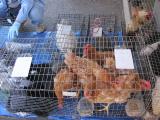China reported seven H7N9 infections, one of them fatal, today from four different provinces, with global health groups highlighting the risk from poultry contact and noting the severe threat the virus poses to those infected.
The flurry of new cases pushed the cases in the second wave of illnesses, under way since October, to 188, well past the 136 cases reported last spring during the first wave.
Five of today's cases are from the two provinces—Guangdong and Zhejiang—that have reported most of the infections in the second wave, representing a more southerly tilt in the illness pattern.
Seven new cases, one fatal
Guangdong province reported three case-patients, two men ages 48 and 62 who are in stable condition and a 59-year-old woman in critical condition, according to ministry statements translated and posted by Avian Flu Diary (AFD), an infectious disease news blog, and FluTrackers, an infectious disease news message board.
Zhejiang province reported two cases, in a 76-year-old woman and a 54-year-old man, who are both hospitalized in critical condition, according to the two online sources.
Hunan province reported an H7N9 infection in a 21-year-old woman who is hospitalized.
The latest fatality is an 81-year-old man from Fujian province, according to AFD and FluTrackers. The newly reported cases lift the outbreak total to 324, according to an ongoing tally compiled by FluTrackers. The man's death raises the unofficial fatality count to 69.
WHO adds epi details for 10 recent cases
In related developments, the World Health Organization (WHO) today provided more epidemiologic information on 10 lab-confirmed cases reported by China on Feb 5. Patient ages range from 5 to 67 years, and illness onsets ranged from Jan 21 to Jan 30. Eight of the patients were from Guangdong and Zhejiang provinces, but the WHO's report also included one from Fujian and one from Guangxi.
Five patients are in critical condition, four are listed in severe condition, and one, a 5-year-old girl from Guangdong province, has a mild illness. Investigations showed that eight of the 10 had been exposed to live poultry or live poultry markets before they got sick. The occupation listed for two of the patients was farmer.
Today's WHO report also included some new details about one of the patients in a possible family cluster in Guangxi province, a 41-year-old woman. Earlier this week media reports said the woman's 5-year-old son got sick a day after her H7N9 infection was confirmed.
The WHO report said the woman became ill while working in Guangdong province's Zhongshan City on Jan 27 and returned to Heng County in Nanning, the Guangxi province capital, the next day. She was hospitalized on Feb 3 and remains in critical condition.
ECDC compares two waves, highlights severe threat
Meanwhile, the European Centre for Disease Prevention and Control (ECDC) today weighed in on the latest outbreak developments in an epidemiologic update, much of it comparing the two waves of disease activity. It said the age and gender patterns in the two peaks do not differ much, though the second peak shows slightly more females infected.
The case-fatality rate (CFR) appears to be lower in the second peak, 11.6% compared with 32% in the first peak, but ECDC cautioned that the CFR could rise among the recent patients owing to disease progression. The ECDC noted that although hospitalization information was scarce for many of the first-wave patients, during the second peak, 171 of 173 patients included in its report have been hospitalized, 149 of them in severe or critical condition at notification time.
Though a few small clusters have been detected, almost all cases are sporadic and have no obvious epidemiologic links. So far no sustained human-to-human spread has been detected.
Most patients had contact with poultry and other live birds, and the most likely scenario is that of a zoonotic avian influenza spread in eastern China. "It is a severe threat to humans because of its severity and genetic features that have human pandemic potential," the ECDC said.
See also:
Feb 7 AFD post
Feb 7 FluTrackers thread
FluTrackers human H7N9 case count
Feb 7 WHO statement
Feb 5 CIDRAP News story "No H7N9 letup as Guangxi detections prompt warning"
Feb 7 ECDC H7N9 epidemiological update


















